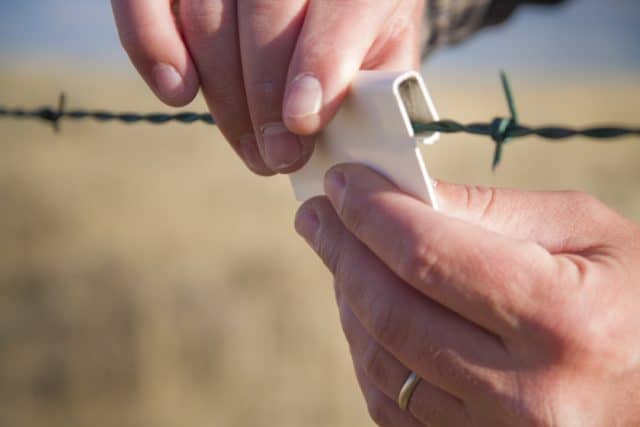
Operation Sage-Grouse: NWF Connects Youth and Conservation
Check out this video from the National Wildlife Federation on win-win partnerships that are making the skies safer for sage grouse through fence marking.

Check out this video from the National Wildlife Federation on win-win partnerships that are making the skies safer for sage grouse through fence marking.

Durable fence markers are typically cut from 3" vinyl strips with reflective tape on both sides to increase visibility in low light. These are snapped onto the top wire at 3-foot intervals. (Photo Jeremy Roberts, Conservation Media)

Sage grouse fly low to the ground across the American West’s sagebrush country. And, as Hayley Newman from the National Wildlife Federation notes, “they don’t always look where they’re going” — especially during spring mating season.
Luckily, marking high-risk fences in prime sage grouse habitat helps the birds navigate safely across the range. Fence marking is one of the Sage Grouse Initiative’s core proactive conservation practices. Since 2010, we’ve worked with dozens of partners and hundreds of ranchers to mark or remove 628 miles of fences, reducing sage grouse collisions by 83 percent.

Low-flying sage grouse can strike unmarked fence wires, resulting in injuries or mortality. (Photo Jeremy Roberts, Conservation Media)
One of those partners is the National Wildlife Federation, a nonprofit group coordinating fence marking projects on public and private land in Montana while engaging youth job corps crews.
In 2016, NWF partnered with Montana Conservation Corps and the Trapper Creek Job Corps, exposing dozens of young adults to potential careers in science as well as teaching them the importance of conserving working lands and wildlife.
So far, NWF has helped mark 130 miles of fences to prevent bird collisions. The group plans to up that to 200 miles during the upcoming 2017 field season. These projects provide the added benefit of giving young people an opportunity to get outside for hands-on, cooperative learning.
Kudos to the many partners making the skies safer for sage grouse!
Learn more about how marking fences saves sage grouse
View the SGI Web App to find high-risk fences near you